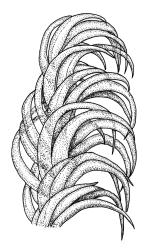Elements in the following description are taken from Hedenäs (2003).
Plants medium-sized to robust, green, brown-green, red, or red-brown, to nearly black, sometimes turgid, forming interwoven mats, often on waterlogged soil. Stems irregularly or subpinnately branched; in cross-section with a hyaloderm (sometimes partial); with or without a small central strand (lacking in N.Z. material). Stem and branch leaves differing only by size. Stem leaves falcate-secund to nearly circinate in N.Z. material, less often ± straight, ovate-lanceolate to broadly ovate, acuminate (in N.Z. material), acute or broadly obtuse, not plicate, sometimes striolate when dry, concave below and often becoming tubulose above, entire or denticulate near apex; mid laminal cells linear, smooth, firm- or less often thin-walled, variably porose; alar cells inflated, forming a small group (only one or two cells in N.Z. material). Costa either elongate and single (in N.Z. material) or short and double or lacking. Axillary hairs as per family. Pseudoparaphyllia foliose. Paraphyllia absent.
Mostly dioicous. Perichaetial leaves plicate. Setae elongate, smooth, ± red; capsule cylindric from a moderately defined neck, curved and ± horizontal, constricted below the mouth when dry; stomata present; annulus differentiated; operculum conic. Exostome teeth pale yellow-brown, cross-striolate below, bordered; endostome well-developed, with a high basal membrane and nodose cilia in groups of 2–3(–5 fide Hedenäs). Calyptra cucullate, naked. Spores finely papillose.
Scorpidium is a small genus interpreted by Hedenäs (2003) to include three species. The type species (S. scorpioides) is widely distributed in the northern hemisphere with outlying high-elevation localities in South America; it occurs mainly in mineral-rich wetlands. S. scorpioides is recorded from Tasmania by both Dalton et al. (1991) and by Hedenäs (2003), but has not been found in N.Z.
Scorpidium cossonii and its close ally S. revolvens are often included in a broadly-defined concept of Drepanocladus (cf. Kanda 1976; Crum & Anderson 1981; Blockeel 2000). Hedenäs (1989) argued for the placement of the northern hemisphere species often referred to as Scorpidium turgescens in the genus Pseudocalliergon.
Hedenäs (1989) has reviewed S. cossonii and S. revolvens in detail for Scandinavia and subsequently (pers. comm., July 1996) applied the name S. cossonii to several N.Z. collections in CHR. Blockeel (2000) applied Hedenäs’s species concepts to British material and clarified the differences between these two species, but retained them in Drepanocladus. Using the characters utilised by both Hedenäs and Blockeel, most N.Z. material can be confidently referred to Scorpidium cossonii. In particular, the width of the shoots (nearly always <2 mm) and the length (mostly 54–75 µm) and ± truncate nature of the ends of the mid laminal cells aid in the recognition of this species. Some problematic collections, from the Arthur's Pass area, are discussed below.
| Category | Number |
|---|---|
| Indigenous (Non-endemic) | 1 |
| Total | 1 |
Scorpidium revolvens (Sw.) Rubers was first recorded from localities on both main islands (as Drepanocladus revolvens) by Dobson (1975); some of this material is better named as S. cossonii. Two non-sexual collections made by him (CHR 241589 and 370180) at the Bealey Saddle (Canterbury L.D.) differ from collections of confirmed S. cossonii by overall size, leaf shape and dimensions, and mid laminal cell details. Hedenäs (in herb. CHR) has expressed the opinion that they are S. revolvens (despite having slightly more striolate dry leaves than European plants). Collections from nearby Temple Basin (e.g., Huang 72, CHR 460882) likewise exhibit intermediate features. It seems unlikely that two comparatively rare species of Scorpidium, both non-sexual, are present near Arthur's Pass. It seems more likely that one species of Scorpidium occurs in N.Z., and that it is more variable here than in other parts of its range. Material from S Auckland that Dobson (1975) cited as D. revolvens is referable to Warnstorfia fluitans. Material which he cited from Otago, Wellington, and Westland L. D. has not been available for study. Unless more convincing material becomes available, it is best to exclude S. revolvens from the N.Z. flora.




